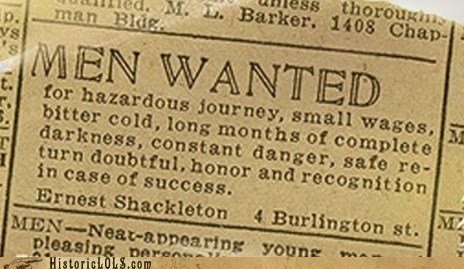10 Awesome Lessons on Innovation from Great Explorers
This advertisement ran in a London newspaper in 1913. Could you have imagined answering it? If you did, you are a real innovator. Besides you, over 1000 men did. They were hoping to be chosen for an Antarctic exploration led by Sir Ernest Shackleton. He gained fame for his 1909 expedition to the South Pole. When I read this ad in one of my travel books it struck me that 100 years later this could have been and ad for an innovation project. Innovation nowadays has so many similarities with voyages of discovery and expeditions in the past. We can learn wise lessons from great explorers.
Christopher Columbus
In 1492 Columbus sailed off the map and thought he discovered a western route to the East. The road to the East was cut off to European traders due to the fall of Constantinople to the Turks. If you wanted to make a fortune you had to find a new route. Unfortunately Columbes estimates on the distance he needed to travel were wrong. He guessed the distance from the Canary Islands to Japan to be about 3,000 Italian miles (3,700 km, or 2,300 statute miles), while the correct figure is 19,600 km (12,200 miles).¹ He called the inhabitants Indians being sure that he had reached the Indies. Actually he landed at Watling Island in the Bahamas and discovered the Americas. Columbus himself was a kind of outsider. He came from Genua with unclear roots and had nothing to lose. Potential profits were a strong motive. His trip was an investment and not an exploration journey. He had an agreement with Queen Isabella of Castile that if he succeeded, he would get a cut of all the proceeds of his discovery. New techniques of navigation, better knowledge of Atlantic currents and the development of caravels made it possible for Columbus to sail much closer to the wind.
Edmund Hillary
Sir Edmund Hillary had been part of a British reconnaissance expedition to Mount Everest in 1951. After eight failed attempts on Everest The British Himalayan Committee replaced the 1951 expedition leader Eric Shipton by Colonel John Hunt. They needed someone to get them on the top, before the French had their chance. The 1953 Everest expedition consisted of a huge team of over 400 people, including 362 porters, 20 Sherpa guides and almost 5.000 kilogram of baggage. Hillary and Norgay were the second assault team for the top. Bourdillon and Evans attempted the climb but due to a failing oxygen system only reached the South Col, around 100 metres below the summit. Then Hillary and Norgay got their chance. The higher you get on Everest the more courage you need. At 7.800 metres Hillary wrote in his diary “Even wearing all my down clothing I found the icy breath from outside penetrating through my bones. A terrible sense of fear and loneliness dominated my thoughts. What is the sense of this all? I asked myself”. A crucial last part of summiting Everest is a 12 meters rock face, which Hillary managed to climb. It’s now known as the Hillary Step. Hillary and Norgay reached the 8,848 meters high summit, the highest point on earth, at 11:30 am on May 29th 1953.
Neil Armstrong
Neil Armstrong learned to fly in the summer of 1946 at the age of sixteen. This was the minimum age to fly a powered airplane. It was rather unusual that he earned his pilot’s license before he got an automobile driver’s license. On April 12, 1961 the Soviet Union stunned the world when cosmonaut Yuri Gagarin became the first human space traveller. President JFK had to restore America’s respect and wanted to prove American superiority. He declared “I believe that this entire nation should commit itself to achieving the goal, before the decade is out, of landing a man on the Moon and returning him safely to Earth. There were three options for landing on the moon: Direct Ascent, Earth Orbit Rendezvous and Lunar Orbit Rendezvous (LOR). To the surprise of many experts, NASA selected in July 1962 the Lunar Orbit Rendezvous. If the Rendezvous failed the astronauts would be too far away to be saved. Most important was that LOR was the only way by which the Moon landing could be achieved by Kennedy’s deadline of decade’s end. After a decade of preparation it almost went wrong at the last moment. In the descent to the Moon suddenly a yellow caution light came on: 1202 program alarm. Armstrong did not know which of the dozen of alarms it presented. Mission Control said it was not critical. And they continued. So there I was, 9 years old. Woken up in the middle of the night at 04.00 by my parents. On a black and white TV I saw Neil Armstrong making his first little jumps on the moon. While he spoke his famous words: “That’s one small step for man, one giant leap for mankind.”
10 lessons on innovation
In the voyages of these great explorers you can find are 10 awesome lessons on innovation.
1. Urgency. For Columbus the road to the East was cut off to European traders by the Turks. President JFK had to restore America’s respect. There must be urgency otherwise innovation is considered as playtime and nobody in your organisation will be prepared to go outside the box.
2, Challenge. Reaching the hightest point on Earth and sailing to the west to find the East are both real concrete challenges.So, start your innovation journey with a clear and big challenge: an innovation assignment.
3. Passion. As a youngster, Hillary was a great dreamer. He read many adventure books. Armstrong earned his pilot’s license at sixteen. If you follow your passion it will take you beyond your limits. So if you are passionate bout innovation, take the lead in your organisation.
4. Courage. In the descent to the Moon suddenly a yellow caution light came on: 1202 program alarm. Armstrong and Aldrin continued. A terrible sense of fear and loneliness dominated the thoughts of Hillary but he continued. If you want to realise a big challenge you have to go beyond your limits.
5. New Technology. The development of caravels made it possible for Columbus to sail much higher at the wind. Look for unproven means like new technology, new media and new business models to reach your goal.
6. Preparation. On the morning of the launch, the first astronaut into the Apollo 11 was Fred Haise, back up as lunar module pilot. He ran through a 417-step checklist designed to ensure that every switch was set in the proper position. You can only start your innovation project once for the first time. Prepare.
7. Teamwork. Hillary wrote: “John Hunt and D. Namgyal’s lift to the depot on the South-East Ridge; George Low, Alf Gregory and Ang Nyima with their superb support at Camp IX; and the pioneer effort by Charles Evans and Tom Bourdillon to the South Summit. Their contribution had enabled us to make such good progress”. Compose a diverse passionate team. A new idea will flourish better with a lot of fathers and mothers.
8. Choices. The British Himalayan Committee replaced the 1951 expedition leader Eric Shipton by Colonel John Hunt, a climber. After eight failed attempts on Everest they needed someone to get them on the top, before the French had their chance. Take clear choices always bearing your assignment in mind.
9. Test. The Apollo 10 was a full-dress rehearsal for Apollo 11. They flew almost precisely the same track over the lunar surface that Apollo 11 would be flying. This was very helpful according to Neil Armstrong: “By the time we launched in July, we knew all the principal landmarks on our descent path by heart”. So test, test and test.
10. Perseverance. Along the way there are always major setbacks. And you and your team will, like Columbus, be scared shitless sometimes. Persevere like famous explorers did before you.
Unfortunately Shackleton’s Trans-Antarctic-expedition was not a success. His ship ‘Endurance’ was destroyed by Arctic ice. But “all safe, all well”: Shackleton rescued all of his 22 men from Elephant Island. So even if you cannot avoid all the innovation pitfalls and you might not reach your goal, bring back your team safely and learn from your joint effort. In innovation the journey itself is as important as the end result. The lessons of these great explorers inspired me to create a structured approach to innovation. You may find the FORTH innovation map helpful guiding your own innovation expedition. Go for it!
—
Gijs van Wulfen is a professional innovation speaker and great storyteller. Watch two movies where you see Gijs ‘live on stage’, here.







